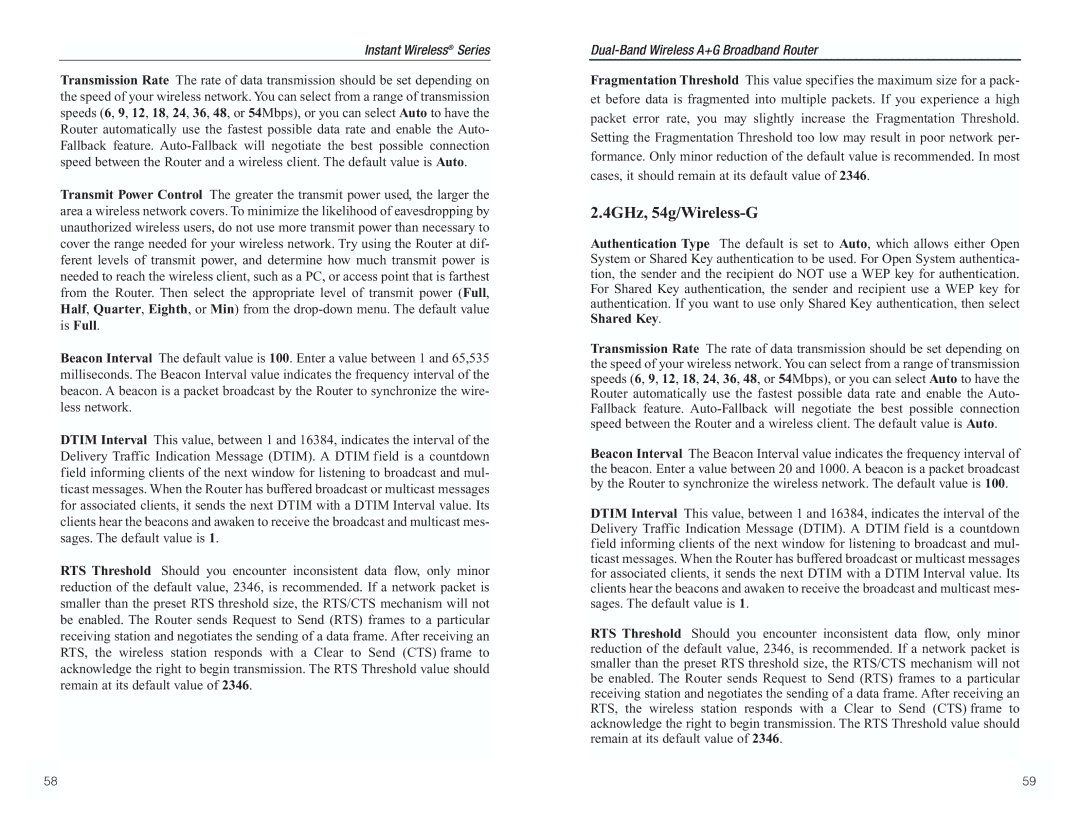Instant Wireless® Series
Transmission Rate The rate of data transmission should be set depending on the speed of your wireless network. You can select from a range of transmission speeds (6, 9, 12, 18, 24, 36, 48, or 54Mbps), or you can select Auto to have the Router automatically use the fastest possible data rate and enable the Auto- Fallback feature. Auto-Fallback will negotiate the best possible connection speed between the Router and a wireless client. The default value is Auto.
Transmit Power Control The greater the transmit power used, the larger the area a wireless network covers. To minimize the likelihood of eavesdropping by unauthorized wireless users, do not use more transmit power than necessary to cover the range needed for your wireless network. Try using the Router at dif- ferent levels of transmit power, and determine how much transmit power is needed to reach the wireless client, such as a PC, or access point that is farthest from the Router. Then select the appropriate level of transmit power (Full, Half, Quarter, Eighth, or Min) from the drop-down menu. The default value
is Full.
Beacon Interval The default value is 100. Enter a value between 1 and 65,535 milliseconds. The Beacon Interval value indicates the frequency interval of the beacon. A beacon is a packet broadcast by the Router to synchronize the wire- less network.
DTIM Interval This value, between 1 and 16384, indicates the interval of the Delivery Traffic Indication Message (DTIM). A DTIM field is a countdown field informing clients of the next window for listening to broadcast and mul- ticast messages. When the Router has buffered broadcast or multicast messages for associated clients, it sends the next DTIM with a DTIM Interval value. Its clients hear the beacons and awaken to receive the broadcast and multicast mes- sages. The default value is 1.
RTS Threshold Should you encounter inconsistent data flow, only minor reduction of the default value, 2346, is recommended. If a network packet is smaller than the preset RTS threshold size, the RTS/CTS mechanism will not be enabled. The Router sends Request to Send (RTS) frames to a particular receiving station and negotiates the sending of a data frame. After receiving an RTS, the wireless station responds with a Clear to Send (CTS) frame to acknowledge the right to begin transmission. The RTS Threshold value should remain at its default value of 2346.
Dual-Band Wireless A+G Broadband Router
Fragmentation Threshold This value specifies the maximum size for a pack-
et before data is fragmented into multiple packets. If you experience a high
packet error rate, you may slightly increase the Fragmentation Threshold.
Setting the Fragmentation Threshold too low may result in poor network per-
formance. Only minor reduction of the default value is recommended. In most
cases, it should remain at its default value of 2346.
2.4GHz, 54g/Wireless-G
Authentication Type The default is set to Auto, which allows either Open System or Shared Key authentication to be used. For Open System authentica- tion, the sender and the recipient do NOT use a WEP key for authentication. For Shared Key authentication, the sender and recipient use a WEP key for authentication. If you want to use only Shared Key authentication, then select Shared Key.
Transmission Rate The rate of data transmission should be set depending on the speed of your wireless network. You can select from a range of transmission speeds (6, 9, 12, 18, 24, 36, 48, or 54Mbps), or you can select Auto to have the Router automatically use the fastest possible data rate and enable the Auto- Fallback feature. Auto-Fallback will negotiate the best possible connection speed between the Router and a wireless client. The default value is Auto.
Beacon Interval The Beacon Interval value indicates the frequency interval of the beacon. Enter a value between 20 and 1000. A beacon is a packet broadcast by the Router to synchronize the wireless network. The default value is 100.
DTIM Interval This value, between 1 and 16384, indicates the interval of the Delivery Traffic Indication Message (DTIM). A DTIM field is a countdown field informing clients of the next window for listening to broadcast and mul- ticast messages. When the Router has buffered broadcast or multicast messages for associated clients, it sends the next DTIM with a DTIM Interval value. Its clients hear the beacons and awaken to receive the broadcast and multicast mes- sages. The default value is 1.
RTS Threshold Should you encounter inconsistent data flow, only minor reduction of the default value, 2346, is recommended. If a network packet is smaller than the preset RTS threshold size, the RTS/CTS mechanism will not be enabled. The Router sends Request to Send (RTS) frames to a particular receiving station and negotiates the sending of a data frame. After receiving an RTS, the wireless station responds with a Clear to Send (CTS) frame to acknowledge the right to begin transmission. The RTS Threshold value should remain at its default value of 2346.

